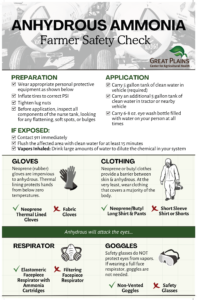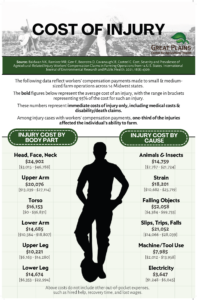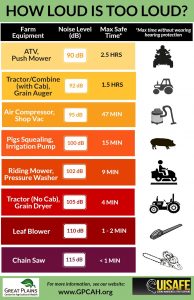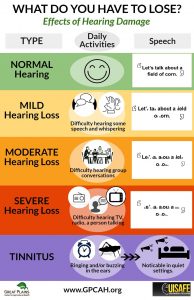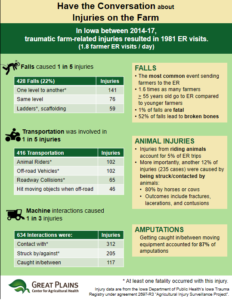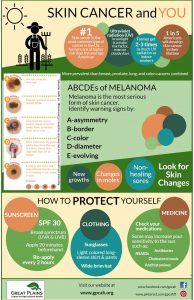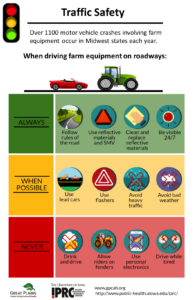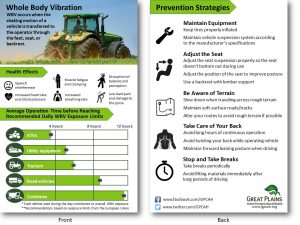Ag Safety and Health Posters
Since 2017, GPCAH has provided free posters and information to Ag Educators throughout the Midwest to assist with educating ag students about health and safety risks and prevention. Click on the titles below to obtain details and publications related to the top. If you click on the poster image, you will find a full-scale poster pdf, suitable for printing on 11×17 paper.
CONTACT US with questions or additional topics of interest.
Take our survey: Let us know if these are helpful and recommend additional topics to add.
New posters for 2023 are available for download now!
Anhydrous Ammonia Safety
While anhydrous ammonia is a common fertilizer, applied to Midwest fields in the late fall after harvest or early spring before planting, it can cause life threatening injuries. If inhaled, it can cause lung irritation, severe respiratory injuries, and can lead to death at higher concentrations. It is corrosive, and it will burn the eyes and skin on contact and can burn the lungs if inhaled.
The anhydrous form means that it is “without water”. Anhydrous ammonia aggressively seeks out moisture with anything it contacts. If it contacts your skin, eyes, or lungs, it will draw water out of tissue, dehydrating and destroying cells. It is extremely important to cover your skin and eyes when handling anhydrous ammonia and to wear respiratory protection during high-risk tasks where it could be inhaled (such as during tank filling, if escaping during a spill). It is also critical to have water to rinse hands and eyes if there is a spill or if it contacts skin: providing another source of water to both react with the ammonia and to wash it off your skin is critical.
How to Use in Class
- Discuss when talking about nutrient application
- Provide PPE to demonstrate safe practices
- Show water tanks and demonstrate wash practices to follow in the field
Additional Resources
- Text review of hazards with a quiz at the end: https://nasdonline.org/1258/d001062/play-it-safe-with-anhydrous-ammonia.html
- Detailed information on anhydrous ammonia hazards: https://www.cdc.gov/niosh/ershdb/emergencyresponsecard_29750013.html
Cost of Injury
How to Use in Class
- Incorporate data from poster when discussing different production operations (by cause)
- Show when needing to motivate safe work practices throughout the program
Additional Resources
- The surveillance study from which these data were extracted is: https://www.mdpi.com/1660-4601/18/8/4309/htm (see table 4)
- Surveillance of Agricultural Injuries and Fatalities web page: http://www.public-health.uiowa.edu/gpcah/center-projects/surveillance-of-agricultural-injuries-and-fatalities/
- Trends in non-fatal agricultural injuries requiring trauma care: https://www.ncbi.nlm.nih.gov/pmc/articles/PMC4669366/
- Characteristics of Fatal Agricultural Injuries by Production Type: https://www.ncbi.nlm.nih.gov/pubmed/27024994
- Surveillance Project, including injury maps and reports: http://www.public-health.uiowa.edu/gpcah/center-projects/surveillance-of-agricultural-injuries-and-fatalities/
- Characteristics of Work- and Non-work-Related Farm Injuries: http://onlinelibrary.wiley.com/doi/10.1111/jrh.12121/full
Gas Monitor Use
How to Use in Class
- Incorporate into livestock operation discussions
- Incorporate into discussions on grain bin storage
- Show when discussing emergency planning and response
Additional Resources
- Manure gas safety resources are compiled at: https://gpcah.public-health.uiowa.edu/outreach-2/topics/2-0/
- Study on performance of low-cost sensors (full access to all) is at: https://anthony.lab.uiowa.edu/article/low-cost-gas-monitor-bench-testing-results
Respirator Seal Check
Many farming operations generate concentrations of dusts (“particles”) or gases that indicate respiratory protection should be worn. Any time you put on a respirator, you want to make sure it is sealed – otherwise, it is not preventing hazardous gases and particles from entering your lungs. The best way to make sure the respirator is sealed is to perform a seal check EVERY TIME you put a respirator on. This poster identifies the simple procedure to follow every time you put on a respirator. It shows how to do this with the filtering facepiece respirator (the “N95”) and with an elastomeric respirator.
How to Use in Class
- Post just outside areas where you want students to put on respiratory protection
- Use in class when discussing tasks that generate airborne hazards that pose risk to farmers (grain transfer, pesticide application, anhydrous ammonia handling and application) to remind students of the protocol
Additional Resources
- Ag Health & Safety Alliance information on respiratory health, including fit checks: https://aghealthandsafety.com/respiratory/
- GPCAH resources on PPE: https://gpcah.public-health.uiowa.edu/respiratory-ppe-resources/
Safely Extracting Stuck Vehicles
How to Use in Class
- When discussing vehicle operation, go over protocols and equipment to safely extract vehicles
- Review the information before demonstrations or inspections of equipment
Additional Resources
- Purdue Extension’s Extracting Stuck Equipment Safely: https://www.extension.purdue.edu/extmedia/ppp/ppp-98.pdf
- FarmSafe Podcast on the topic, with Fred Whitford: https://gpcah.public-health.uiowa.edu/march-mudness/
Hearing Damage: How Loud is Too Loud?
Click the photo above to download the poster on
Interpreting Sound Levels and How Long You Are Safe Without Hearing Protection
How to Use in Class
- When discussing personal protection, risk prevention and management
- Incorporate early in programs when demonstrating loud equipment
- Discuss before internships begin
Additional Resources
- Center information on hearing loss and protection: http://www.public-health.uiowa.edu/gpcah/fact-sheets/hearing-loss/
.
Hearing Damage: What Do You Have to Lose?
Farm workers suffer from impaired communication, reduced self-esteem, and disrupted intimacy, a result of noise-induced hearing loss. Most also experience tinnitus, a constant ringing or buzzing in the ears. Farm workers are exposed to excessive noise from: tractors, dryers, silage blowers, mowers, livestock, and chain saws, to name a few. Exact numbers are hard to pin down, but studies in 2000 estimate that 72% of farmers have hearing loss. Since hearing loss gradually develops over a working lifetime, early prevention will have great payoffs later in life. This poster explains how future hearing loss may affect common activities. The right side uses disappearing words to visually illustrate how changing of hearing loss affects the ability to communicate as the disease progresses.
How to Use in Class
- When discussing personal protection, risk prevention and management
- Incorporate early in programs when demonstrating loud equipment
- Discuss before internships begin
Additional Resources
- Center information on hearing loss and protection: http://www.public-health.uiowa.edu/gpcah/fact-sheets/hearing-loss/
How Farmers Get Hurt
Data from emergency room records and farmer fatality cases have been used to understand risk factors: How do farmers get hurt?
Click the photo above to download a poster illustrating key injuries to farmers,
using recent fatality data.
How to Use in Class
- To remind students of injury risks Incorporate into discussions focused on driving safety, material handling, machinery and livestock production
Additional Resources
- Surveillance of Agricultural Injuries and Fatalities web page: http://www.public-health.uiowa.edu/gpcah/center-projects/surveillance-of-agricultural-injuries-and-fatalities/
- Trends in non-fatal agricultural injuries requiring trauma care: https://www.ncbi.nlm.nih.gov/pmc/articles/PMC4669366/
- Characteristics of Fatal Agricultural Injuries by Production Type: https://www.ncbi.nlm.nih.gov/pubmed/27024994
- Surveillance Project, including injury maps and reports: http://www.public-health.uiowa.edu/gpcah/center-projects/surveillance-of-agricultural-injuries-and-fatalities/
- Characteristics of Work- and Non-work-Related Farm Injuries: http://onlinelibrary.wiley.com/doi/10.1111/jrh.12121/full
Skin Cancer and You
Farmers work outdoors and, by default, are at risk of developing skin cancer from ultraviolet light. Understanding the risk is important to motivate farmers to take simple precautionary actions.
How to Use in Class
- Incorporate into discussions on risk management, health care, personal protective equipment.
- Show how to recognize what type of skin changes warrant going to the doctor.
Additional Resources
- General skin cancer risks and information: http://www.skincancer.org/skin-cancer-information/skin-cancer-facts
- Information from the FDA on what medications increase your sensitivity to sun: http://www.fda.gov/Drugs/ResourcesForYou/SpecialFeatures/ucm464195.htm
Tractor Safety: How to Prevent Injuries
To protect farmers, discussions on how to prevent injuries on tractors is needed. The top five types of injuries identified as significant when evaluating databases of fatal and non-fatal injuries are identified. Specific recommendations to prevent falls, collisions, and entanglement in machines are identified. Specific recommendations to both prevent rollovers and to reduce the injuries if a rollover occurs are included.
How to Use in Class
- Review when discussing tractor operation and safety
- Incorporate into machine maintenance discussions
Additional Resources
- Lighting and marking policies are associated with reduced farm equipment-related crash rates: a policy analysis of nine Midwestern US states: http://oem.bmj.com/content/73/9/621
- Nonfatal tractor-related injuries presenting to a state trauma system: https://www.ncbi.nlm.nih.gov/pubmed/25934002 or http://www.sciencedirect.com/science/article/pii/S0022437515000146
- Example fatality investigation cases to illustrate injury mechanisms:
- Tractor overturn: http://www.public-health.uiowa.edu/face/Reports/PDF-Reports/2005IA015.pdf
- Moving round bales: http://www.public-health.uiowa.edu/face/Reports/PDF-Reports/2005IA013.pdf
- Trapped under combine: http://www.public-health.uiowa.edu/face/Reports/PDF-Reports/2008IA081.pdf
- Riding equipment: http://www.public-health.uiowa.edu/face/Reports/PDF-Reports/2011IA039.pdf
- Overturned: https://www.cdc.gov/niosh/face/stateface/mi/10MI021.html
- Rear-ended by semi: https://www.cdc.gov/niosh/face/stateface/mi/07mi044.html
- Entangled in PTO shaft: http://www.public-health.uiowa.edu/face/Reports/PDF-Reports/Flight%20Elevator%20PTO.pdf
- ASABE Standards:
- Lighting and Marking of Agricultural Equipment on Highways ANSI/ASAE S279.17 Jul 2013
- Roll-Over Protective Structures for Wheeled Agricultural Tractors SAE J1194:1994
- Roll-Over Protective Structures for Compact Utility Tractors ANSI/ASAE S478.1 Feb 2012 R2016
Traffic Safety
How to Use in Class
- Review when discussing tractor operation and safety
- Review prior to planting and harvesting seasons
Additional Resources
- Lighting and marking study: http://oem.bmj.com/content/73/9/621
- Surveillance of agricultural injuries: http://www.public-health.uiowa.edu/gpcah/center-projects/surveillance-of-agricultural-injuries-and-fatalities/
- Lighting and marking recommendations are summarized in this press release: https://now.uiowa.edu/2016/10/more-stringent-state-policies-lighting-could-reduce-farm-vehicle-traffic-accidents-more-half
- See a round up of media articles on vehicle crashes with tractors: http://www.public-health.uiowa.edu/news-items/ui-study-more-lighting-on-farm-vehicles-would-reduce-number-of-crashes/
Tractor-Related Injuries
Data from emergency room records were used to identify leading sources and events associated with how farmers are hurt on tractors. This poster provides information on how Midwest farmers and their families have been hurt when working on and near tractors.
How to Use in Class
- Review when discussing tractor operation and safety
- Incorporate into machine maintenance discussions
Additional Resources
- Characteristics of Farm Equipment-Related Crashes Associated With Injury in Children and Adolescents on Farm Equipment: http://onlinelibrary.wiley.com/doi/10.1111/jrh.12162/abstract
- Lighting and marking policies are associated with reduced farm equipment-related crash rates: a policy analysis of nine Midwestern US states: http://oem.bmj.com/content/73/9/621
- A GIS-based Matched Case-control Study of Road Characteristics in Farm Vehicle Crashes: https://www.ncbi.nlm.nih.gov/pubmed/27468005
- Nonfatal tractor-related injuries presenting to a state trauma system: https://www.ncbi.nlm.nih.gov/pubmed/25934002 or http://www.sciencedirect.com/science/article/pii/S0022437515000146
Whole Body Vibration
Click the photo above to download the poster on What Whole Body Vibration Is and How It Affects Your Health
How to Use in Class
- Discuss how maintaining equipment helps not only good farming but can lead to improved health
- In driving instruction classes, talk about the trade-off of speed and whole body vibration
Additional Resources
- Musculoskeletal pain among Midwest farmers and associations with agricultural activities: https://www.ncbi.nlm.nih.gov/pubmed/25345841
- Information on the study: http://www.public-health.uiowa.edu/gpcah/center-projects/musculoskeletal-symptoms-among-farmers/

